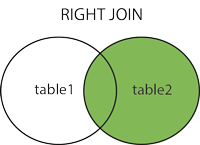MySQL RIGHT JOIN Keyword
MySQL RIGHT JOIN Keyword
The RIGHT JOIN keyword returns all records from the right table (table2), and the
matching records (if any) from the left table (table1).

RIGHT JOIN Syntax
SELECT column_name(s)
FROM table1
RIGHT JOIN table2
ON table1.column_name = table2.column_name;
Demo Database
In this tutorial we will use the well-known Northwind sample database.
Below is a selection from the "Orders" table:
| OrderID | CustomerID | EmployeeID | OrderDate | ShipperID |
|---|---|---|---|---|
| 10308 | 2 | 7 | 1996-09-18 | 3 |
| 10309 | 37 | 3 | 1996-09-19 | 1 |
| 10310 | 77 | 8 | 1996-09-20 | 2 |
And a selection from the "Employees" table:
| EmployeeID | LastName | FirstName | BirthDate | Photo |
|---|---|---|---|---|
| 1 | Davolio | Nancy | 12/8/1968 | EmpID1.pic |
| 2 | Fuller | Andrew | 2/19/1952 | EmpID2.pic |
| 3 | Leverling | Janet | 8/30/1963 | EmpID3.pic |
MySQL RIGHT JOIN Example
The following SQL statement will return all employees, and any orders they might have placed:
Example
SELECT Orders.OrderID, Employees.LastName, Employees.FirstName
FROM Orders
RIGHT JOIN Employees ON Orders.EmployeeID = Employees.EmployeeID
ORDER BY Orders.OrderID;
Try it Yourself »
Note: The RIGHT JOIN keyword returns all records from the
right table (Employees), even if there are no matches in the left table
(Orders).


